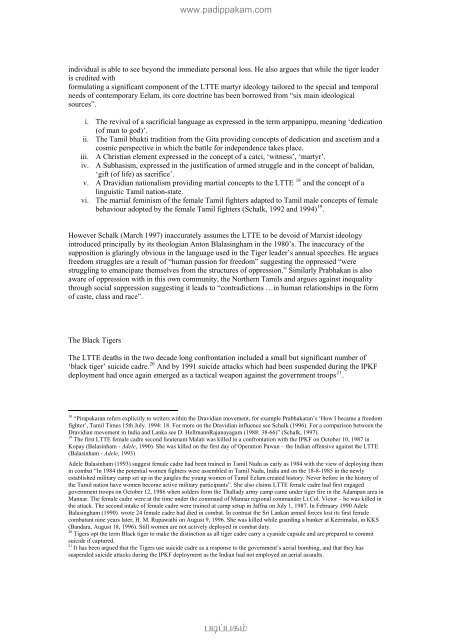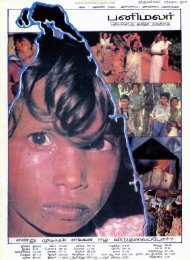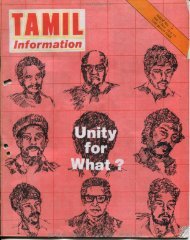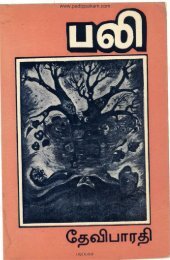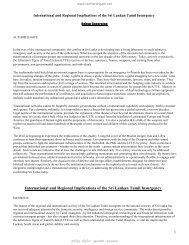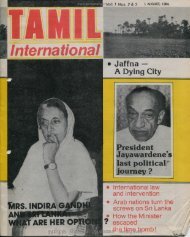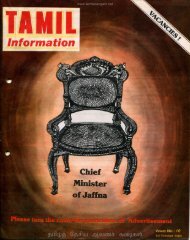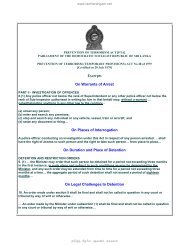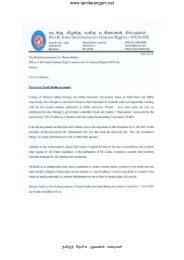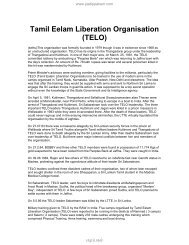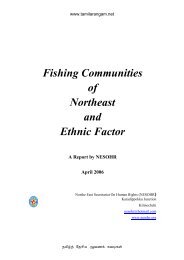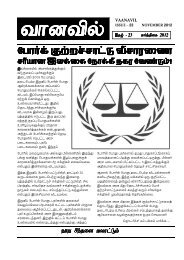Velupillai Prabhakaran: an illusive leader
Velupillai Prabhakaran: an illusive leader
Velupillai Prabhakaran: an illusive leader
Create successful ePaper yourself
Turn your PDF publications into a flip-book with our unique Google optimized e-Paper software.
individual is able to see beyond the immediate personal loss. He also argues that while the tiger <strong>leader</strong><br />
is credited with<br />
formulating a signific<strong>an</strong>t component of the LTTE martyr ideology tailored to the special <strong>an</strong>d temporal<br />
needs of contemporary Eelam, its core doctrine has been borrowed from “six main ideological<br />
sources”.<br />
i. The revival of a sacrificial l<strong>an</strong>guage as expressed in the term arpp<strong>an</strong>ippu, me<strong>an</strong>ing ‘dedication<br />
(of m<strong>an</strong> to god)’.<br />
ii. The Tamil bhakti tradition from the Gita providing concepts of dedication <strong>an</strong>d ascetism <strong>an</strong>d a<br />
cosmic perspective in which the battle for independence takes place.<br />
iii. A Christi<strong>an</strong> element expressed in the concept of a catci, ‘witness’, ‘martyr’.<br />
iv. A Subhasism, expressed in the justification of armed struggle <strong>an</strong>d in the concept of balid<strong>an</strong>,<br />
‘gift (of life) as sacrifice’.<br />
v. A Dravidi<strong>an</strong> nationalism providing martial concepts to the LTTE 18 <strong>an</strong>d the concept of a<br />
linguistic Tamil nation-state.<br />
vi. The martial feminism of the female Tamil fighters adapted to Tamil male concepts of female<br />
behaviour adopted by the female Tamil fighters (Schalk, 1992 <strong>an</strong>d 1994) 19 .<br />
However Schalk (March 1997) inaccurately assumes the LTTE to be devoid of Marxist ideology<br />
introduced principally by its theologi<strong>an</strong> Anton Blalasingham in the 1980’s. The inaccuracy of the<br />
supposition is glaringly obvious in the l<strong>an</strong>guage used in the Tiger <strong>leader</strong>’s <strong>an</strong>nual speeches. He argues<br />
freedom struggles are a result of “hum<strong>an</strong> passion for freedom” suggesting the oppressed “were<br />
struggling to em<strong>an</strong>cipate themselves from the structures of oppression.” Similarly Prabhak<strong>an</strong> is also<br />
aware of oppression with in this own community, the Northern Tamils <strong>an</strong>d argues against inequality<br />
through social suppression suggesting it leads to “contradictions …in hum<strong>an</strong> relationships in the form<br />
of caste, class <strong>an</strong>d race”.<br />
The Black Tigers<br />
www.padippakam.com<br />
The LTTE deaths in the two decade long confrontation included a small but signific<strong>an</strong>t number of<br />
‘black tiger’ suicide cadre. 20 And by 1991 suicide attacks which had been suspended during the IPKF<br />
deployment had once again emerged as a tactical weapon against the government troops 21 .<br />
18<br />
“Pirapakar<strong>an</strong> refers explicitly to writers within the Dravidi<strong>an</strong> movement, for example <strong>Prabhakar<strong>an</strong></strong>’s ‘How I became a freedom<br />
fighter’, Tamil Times 15th July. 1994: 18. For more on the Dravidi<strong>an</strong> influence see Schalk (1996). For a comparison between the<br />
Dravidi<strong>an</strong> movement in India <strong>an</strong>d L<strong>an</strong>ka see D. Hellm<strong>an</strong>nRaj<strong>an</strong>ayagam (1988: 38-66)” (Schalk, 1997).<br />
19<br />
The first LTTE female cadre second lieuten<strong>an</strong>t Malati was killed in a confrontation with the IPKF on October 10, 1987 in<br />
Kopay (Balasinham - Adele, 1990). She was killed on the first day of Operation Paw<strong>an</strong> – the Indi<strong>an</strong> offensive against the LTTE<br />
(Balasinham - Adele, 1993)<br />
Adele Balasinham (1993) suggest female cadre had been trained in Tamil Nadu as early as 1984 with the view of deploying them<br />
in combat “In 1984 the potential women fighters were assembled in Tamil Nadu, India <strong>an</strong>d on the 18-8-1985 in the newly<br />
established military camp set up in the jungles the young women of Tamil Eelam created history. Never before in the history of<br />
the Tamil nation have women become active military particip<strong>an</strong>ts”. She also claims LTTE female cadre had first engaged<br />
government troops on October 12, 1986 when solders form the Thallady army camp came under tiger fire in the Adamp<strong>an</strong> area in<br />
M<strong>an</strong>nar. The female cadre were at the time under the comm<strong>an</strong>d of M<strong>an</strong>nar regional comm<strong>an</strong>der Lt.Col. Victor – he was killed in<br />
the attack. The second intake of female cadre were trained at camp setup in Jaffna on July 1, 1987. In February 1990 Adele<br />
Balasingham (1990) wrote 24 female cadre had died in combat. In contrast the Sri L<strong>an</strong>k<strong>an</strong> armed forces lost its first female<br />
combat<strong>an</strong>t nine years later, H. M. Rupawathi on August 9, 1996. She was killed while guarding a bunker at Keerimalai, in KKS<br />
(B<strong>an</strong>dara, August 18, 1996). Still women are not actively deployed in combat duty.<br />
20<br />
Tigers opt the term Black tiger to make the distinction as all tiger cadre carry a cy<strong>an</strong>ide capsule <strong>an</strong>d are prepared to commit<br />
suicide if captured.<br />
21<br />
It has been argued that the Tigers use suicide cadre as a response to the government’s aerial bombing, <strong>an</strong>d that they has<br />
suspended suicide attacks during the IPKF deployment as the Indi<strong>an</strong> had not employed <strong>an</strong> aerial assaults.<br />
gbg;gfk;


